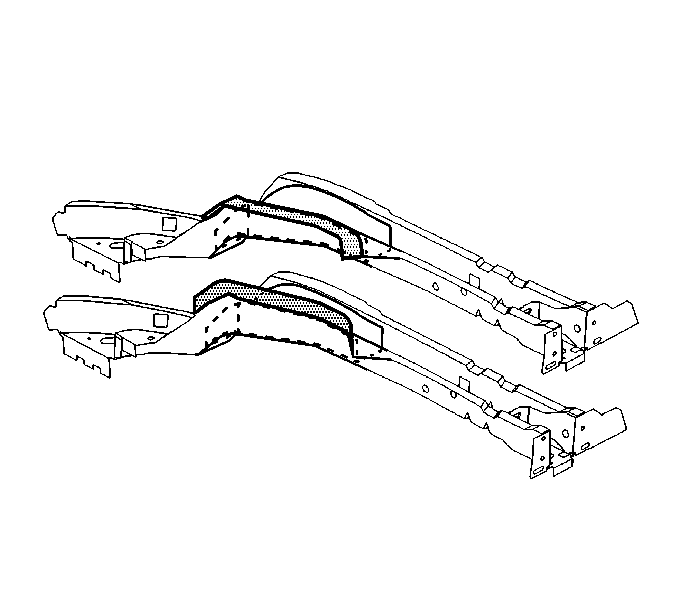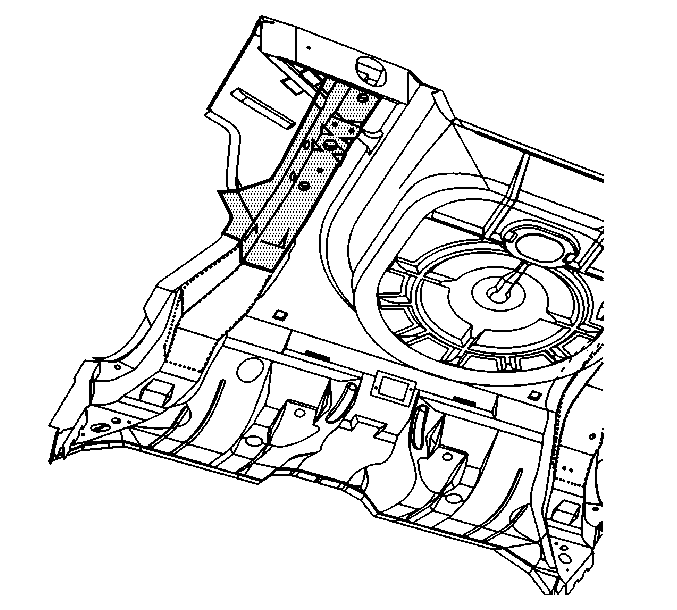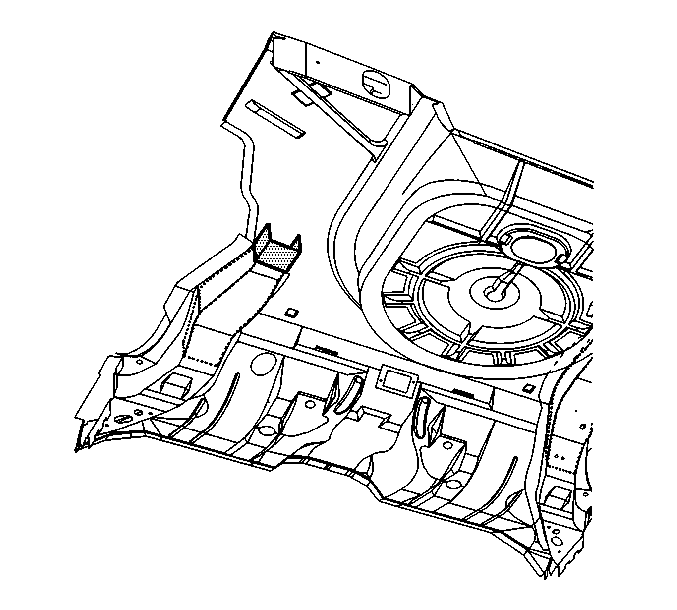The left and the right rear rails are available as complete sub-assemblies and are replaced as complete sub-assemblies. Sectioning can be used in order to simplify the repairs if the damage is limited to the rear 600 mm (24 in) of the rail. Templates and instruction sheets are included with the components in order to facilitate the servicing.

The weld flange that mates with the wheelhouse must be bent upwards when the rail sub-assembly is replaced. The service assembly provides the flange in a horizontal position.
Prepare the service component prior to removing the damaged section of the rail from the vehicle in order to acheive the following results:
| • | Become familiar with the procedure |
| • | Know exactly where to cut the damaged rail |
| • | Locate the rear rail inner reinforcement |
Service Part Preparation
- Invert the service component and secure the component to a bench for cutting.
- Align the appropriate template on the underside of the rail.
- Remove the template and connect the dots with a straight edge in order to scribe the cut line.
- Cut through the outer panel and inner reinforcement along the final cut line and remove the excess portion of the service component.
- Drill out the welds attaching the inner reinforcement to the outer panel (typically 3 welds).
- Remove the inner reinforcement.
Punch through the template with a center punch or an awl in order to mark the rail.
Important: The cut lines for the left and the right sides are in different positions. Make sure to use the appropriate template. Do not damage the template since the template must be used to mark the original rail. Attach the template with a non-permanent spray adhesive such as 3M™ Repositionable Adhesive P/N 6091.
Removal Procedure
- Remove all of the related panels and components including the following components:
- Inspect for damage.
- Remove the following components as necessary:
- Align the appropriate template on the underside of the rail.
- Remove the template and connect the dots with a straight edge in order to scribe the cut line.
- Perform the following actions to the factory welds rearward of the marked cutline, including the welds that secure the rear rail inner reinforcement to the outer panel. Do not drill through the inner reinforcement:
- Cut the rail along the rough cut line.
- Remove the damaged section of the rear rail.
- Slightly pry the reinforcement inwards in order to separate the side walls of the inner reinforcement from the outer panel of the rail.
- Cut the sides of the rail outer panel along the final cut line without damaging the inner reinforcement.
- Bend the rail down and up until the outer panel breaks along the partial cut.
- Remove the damaged section of the rear rail.
| • | The fuel tank |
| • | The fuel filler neck |
| • | The exhaust system |
Restore as much of the damage as possible to factory specifications.
| • | The sealers |
| • | The sound deadeners |
| • | The anti-corrosion materials |
Punch through the template with a center punch or an awl in order to mark the rail.

| 6.1. | Locate |
| 6.2. | Mark |
| 6.3. | Drill out |
Cut along the bottom of the outer panel approximately 3/4 the depth of the metal.
Important: Do not cut the inner reinforcement. This reinforcement acts as a backing plate when welding the new rail section in place.

Leave the reinforcement extending from the inside of the remaining rail section.
Installation Procedure
- Prepare the mating surfaces and position the service component.
- Use the body dimensions and the plug weld in order to inspect for the correct fit. Inspect the measurements on a frequent basis.
- Stitch the weld along the entire joint.
- Make 25 mm (1 in) welds along the seam with 25 mm (1 in) gaps between the welds.
- Complete the stitch weld.
- Clean and prepare the welded surfaces.
- Prime with two-part catalyzed primer.
- Apply sealers and anti-corrosion materials as necessary.
- Install all the related panels and the components.
Allow the component to slide over the inner reinforcement and extend from the original rail section.

Important: Plug weld the inner reinforcement to the new rail section. This may require drawing the reinforcement flat against the rail. Install the backing plates on either side of the original rail above the inner reinforcement, if necessary. The backing plates can be cut from the unused inner reinforcement of the service part. Drill holes and plug weld the backing plates in place.
To ensure a secure weld, the sectioning joint should have a gap of approximately 1½ times the thickness of the metal. Trim the parts as necessary to achieve this.Important: Prior to refinishing, refer to GM 4901MD-99 Refinish Manual for recommended products. Do not combine paint systems. Refer to paint manufacturer's recommendations.
